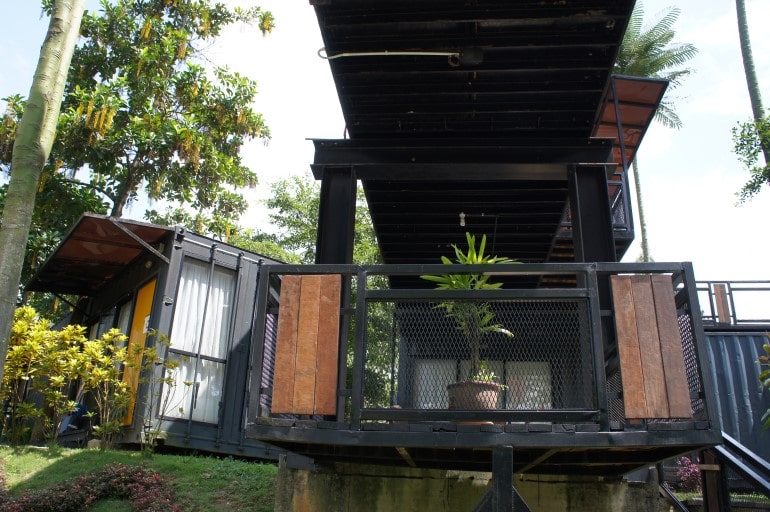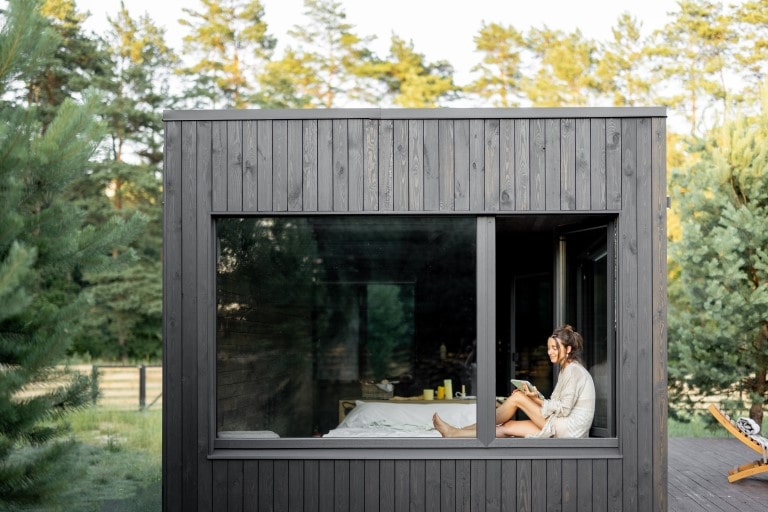Could a shipping container ‘tiny house’ be a solution for someone seeking a place of their own in Australia? In this article, we will look at the tiny house movement in the country and examine the ins and outs of moving into a small shipping container home.
The cost of housing
Australia’s cities are some of the most expensive in the world – in Brisbane, the average home price in March 2021 was $548,260, while in Sydney, it was $1,186,518 – far too expensive for someone on an average income. The average income in Queensland is just over $85,000.
Real estate prices have even begun hitting national news, check out this report from 7 News:
While several factors can contribute to increases in the housing market, the COVID-19 pandemic has influenced the housing crisis.
The government has tried to ease the housing crisis, such as increasing the age for parents to apply for a First Home Owner Grant from 21 to 25 years, capping interest-only loans at 30 years and reducing loans to 40% of a property value equity is less than $500,000.
Even with these measures in place, many Australians are still struggling to afford a home.
Generally, people spend around a third of their income on rent or mortgage, so for someone on $88k, they would about afford to pay off their home in 18 years in Brisbane.
In Sydney? With the average income in NSW just under $92,000, this would be closer to 38 years, and few mortgage lenders are prepared to give people a 38-year mortgage. This makes most people unable to get on the housing ladder in the city unless they win Lotto.
But do you really need to wait that long to get into your very own and fully customised home?
Stepping up into alternative living spaces
While living in a tiny home is certainly cheaper than your average home, most people building tiny houses don’t go into them for the cost alone. They are pulled to the lifestyle rather than pushed. Rounding down the square foot of your apartment, granny flat house, cabin, or multi-floor home does not have to be seen as a downgrade.
Speaking to the Australian Daily Telegraph, Darren Hughes, founder of the Tiny Houses Australia Facebook community, said, “There is a shift happening, and many people are starting to question what life is really about. When they see a high-quality, well-designed tiny house and step inside, they soon realise that they could actually live in such a space.”
Hughes’ Facebook page has more than 58,000 followers worldwide, with people of a whole range of backgrounds getting into the idea. And, why wouldn’t you want to, with tiny home living reviews like this:
With the tiny home movement growing every year, it’s no wonder shipping container houses are on the rise. Custom container living is perfect for people looking to get into a tiny home faster. With various sizes, from 10ft shipping containers through to 40ft shipping containers, you can create a unique tiny home to suit your needs.
Shipping container tiny homes provide the ultimate solution with fast and affordable living! A larger container might become the perfect central hub for your family, while a 20ft container (typically the average container size) could make the perfect master suite.
Economic benefits of building with shipping containers
Cost of custom container living
A shipping container tiny house can cost as little as $30-$40,000 fully fitted, which is less than many mortgage providers would require as a deposit on your home before they lend you the money for your $500,000 average home. Square feet cost savings are seen regardless of the number of metal shipping containers and the size of the floor plan.
This isn’t just the case for modern container house alternative living spaces. If you are looking at adding in an office space that has all the comforts of home without renting or buying something that feels stale and corporate, look no further than a steel shipping container.
Electricity usage of shipping container homes
The environment is another issue. Australia’s homes are some of the biggest in the world. To deal with the extreme weather, it is estimated that the average Australian home consumes 18 tonnes of carbon dioxide per year, heating the world even more and contributing to the worsening weather that hits Australia annually.
Tiny houses require far less energy to keep going than a sprawling two storey home, and many people go a step further by generating their own energy on-site. Those who are very clever draw water from local watercourses and can live completely off-grid, meaning that their carbon footprint is tiny, and they certainly aren’t paying for someone else to have a carbon footprint 20 times the size of their own.
However, even if you want a full-size kitchen complete with all the mod con kitchen appliances, there are plenty of ways to be energy efficient in your on or off grid modern container house.
Reduce, reuse, recycle
If you are environmentally conscious, you will love that by embarking on this journey, your choice of materials will be reused, and your construction method will reduce the amount of time it takes to build your home. This also becomes an attractive option because it reduces the cost too!
You can carry this ethos across to your furniture and kitchen appliances as well. Whether you create built-in furniture options or thrift the perfect fit, making a single shipping container look like a family home is not an impossible task.
Downsizing into a shipping container tiny home
What about the garage you can’t walk into due to the rubbish piled up inside you used once and never saw again? The tiny house concept is that you don’t have the space to buy rubbish and consume far less simply because you don’t have space for that rubbish to accumulate.
You then have the ‘empty nesters’, people who have had their kids fly the nest and want to spend their money on enjoying life. Some parents are known to sell their homes to put a down payment on their children’s homes to help them afford somewhere to bring up their own kids, while other people would rather live it up and see the world with their hard-earned money.
Are you trying to plan your way to debt-free living, check out this family that has actually done it by downsizing:
More money for the fun things
If you sold your $1 million home (that you had 100% of the equity in over 20 years) and moved into a high end, $150,000 shipping container tiny house, you’d have a lot of cash remaining in your pocket to spend on other luxuries. Not everyone living in a small space is skint – trip to Vegas, anyone?!
Things to consider before leaping into a tiny container house

As indicated above, most people aren’t simply moving into a shack because they haven’t two beans to rub together. The tiny house movement is one of comfort and innovation, with some quite spectacular yet small homes. Though it does help if you have a plan before you go into it.
This section will cover the essential things you need to consider before buying a shipping container from Gateway Container Sales.
How much do you want to spend?
You can spend as little as $30,000 on a shipping container home, but you could spend $300,000 if you wanted the best shipping container tiny house that was ever built. Consider the factors below and your budget. Will your preferred bank finance a shipping container home? Some do, so make sure you reach out before planning!
What do you want from your shipping container tiny house?
Do you want to be off-grid and low energy? Do you want the latest gadgets and high energy consumption on the grid? How should it appear?
Is the home to be a fixed installation?
If it has wheels, it could be subject to lighter touch local building regulations. If it is still a relatively intact shipping container (without too many external fittings or combined with one or two others as a unit), then you should put it onto a container truck and shift it elsewhere should the authorities get interested in what you are doing.
Local bureaucracy
For those who want to stay in one place and want to play the game and not live a life looking over their shoulder for council inspectors, you need to plan your home to meet local building regulations. Find out which states allow these types of buildings before getting too far ahead.
Get help from a local planning consultant and a structural engineer or an architect before you leap – we considered these issues in a previous blog on the Gateway Gazette.
Where do you want it?
Are you going off into the bush to live completely off-grid, or do you want to build it in your parents’ garden as a granny flat? This will inform a whole range of things from appearance to the way you fit it out.
Consider how you will power it
Solar energy? Wind power? Plugged into the mains? It would help if you also designed utilities to appear or not appear as you would want them.
How many containers do you need?
You might want one in a small space or stack two together for an upstairs bedroom or another as a workshop.
Windows – add a feeling of space and light
Windows and any other holes in the wall will involve cutting the container walls and therefore need reinforcement around them as the walls are part of the container’s structural strength. Windows, however, add light and give an illusion of spaciousness.
Consider dual-purpose fixtures and fittings
Sofas can be storage spaces. Beds can fold up to the wall, allowing the same space to be a living, working or socialising space. You could fold your dining room and have a living room. Fold your bedroom into an office. You’d be amazed as to how such a small space can do so many things!
Do you need walls inside?
If you’re on your own, you may not even need a space-hungry stud wall for your toilet or shower space.
While all of these steps might seem daunting, once you’re finished the build process it will feel like it’s gone as fast as this timelapse:
If you’ve finalised all the basic decisions, you might find it’s time to get hold of an architect or engineer, and design the home.
Gateway Containers can help you with your tiny home

Gateway Container Sales offer new and used containers at a reasonable price and we can help you start the process.
While we don’t sell shipping container homes or home kits, we have industry networks to point you in the right direction when it comes to putting everything together.
As with everything in life, it helps to have a certain idea before you call. Read around the Gateway Gazette for some ideas, and get in touch!





